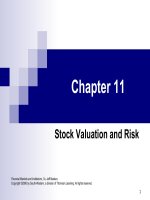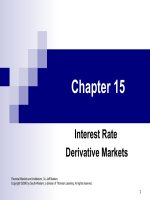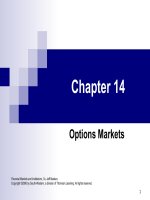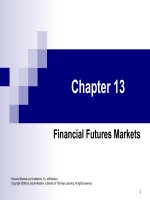Tài liệu Thị trường tài chính và các định chế tài chính_ Chapter 04 docx
Bạn đang xem bản rút gọn của tài liệu. Xem và tải ngay bản đầy đủ của tài liệu tại đây (300.15 KB, 35 trang )
1
Chapter 4
Functions of the Fed
Financial Markets and Institutions, 7e, Jeff Madura
Copyright ©2006 by South-Western, a division of Thomson Learning. All rights reserved.
2
Chapter Outline
Organization of the Fed
Monetary policy tools
Impact of technical factors on funds
Fed control of the money supply
Monetary Control Act of 1980
Global monetary policy
3
Organization of the Fed
The Fed has five major components:
Federal Reserve district banks
Member banks
Board of Governors
Federal Open Market Committee (FOMC)
Advisory committees
4
Organization of the Fed (cont’d)
Federal Reserve district banks
There are 12 Federal Reserve district banks
The NY bank is the most important
Commercial banks that become members of the Fed must
purchase stock in their district banks
Pays a maximum dividend of 6% annually
Each district bank has nine directors
Six elected by member banks; three appointed by the Board of
Governors
The nine directors appoint the president of the district bank
District banks clear checks, replace old currency, provide loans
to depository institutions, and conduct research
5
Organization of the Fed (cont’d)
Member banks
All national banks are required to be members of the
Fed
State-chartered banks are not required to be
members
About 35% of all banks are members
6
Organization of the Fed (cont’d)
Board of Governors
The Board of Governors consists of seven members
Each member is appointed by the President of the
U.S. and confirmed by the Senate
Members serve 14-year terms
Reduces political pressure
Terms are staggered so that one term expires in every even-
numbered year
Main roles:
Regulate commercial banks
Control monetary policy
7
Organization of the Fed (cont’d)
Federal Open Market Committee (FOMC)
The FOMC consists of the seven members of the
Board of Governors plus the presidents of five Fed
district banks
NY plus four others on a rotating basis
Goals: promote high employment, economic growth,
and price stability
Achieved through control of the money supply
Decisions on changes in monetary policy are
forwarded to the Trading Desk (Open Market Desk)
at the NY Fed district bank
8
Organization of the Fed (cont’d)
Advisory committees
The Federal Advisory Council consists of one member from
each district
Makes recommendations to the Fed about economic and banking
issues
The Consumer Advisory Council consists of up to 30 members
Represents the financial institutions industry and its consumers
The Thrift Institutions Advisory Council consists of
representatives of savings banks, S&Ls, and credit unions
Offers views on issues specifically related to thrift institutions
9
Integration of Federal Reserve
Components
Advisory
Committee
Board of Governors
•
Regulates member
banks and BHCs
•
Sets reserve
requirements
Supervision
Federal Open
Market Committee
•
Conducts open
market operations
Federal Reserve
District Banks
•
Clear checks
•
Replace old currency
•
Provide loans to
depository institutions
10
Monetary Policy Tools
Open market operations
The FOMC meets 8 times a year
At each meeting, the target money supply growth level and
interest rate level are determined
FOMC meeting agenda
Members receive the Beige Book two weeks prior to the meeting
Meeting is attended by the Board of Governors, the 12 presidents of
the district banks, and staff members
Staff members begin with presentations about current economic
conditions and recent economic trends
Next, each FOMC member can offer recommendations about
whether monetary growth and interest rate target levels should be
changed
Last, voting members vote on monetary policy and interest rates
11
Monetary Policy Tools (cont’d)
Open market operations (cont’d)
Communication to the Trading Desk
The FOMC’s decision on target money supply levels is
forwarded to the Trading Desk at the NY district bank through
a policy directive
FOMC objectives are specified in a target range for the
money supply growth
The FOMC also specifies a desired target for the federal
funds rate
The federal funds rate is the rate charged by banks on short-
term loans to each other
12
Monetary Policy Tools (cont’d)
Open market operations (cont’d)
Role of the Trading Desk
The manager of the Trading Desk instructs traders on the amount of
government securities to buy or sell in the secondary market
This is called open market operations
The Trading Desk continuously conducts open market operations in
response to ongoing changes in bank deposit levels
13
Monetary Policy Tools (cont’d)
Open market operations (cont’d)
Fed purchase of securities
Traders at the Trading Desk call government securities
dealers to purchase securities
Dealers provide a list of securities for sale
Traders purchase those that are most attractive
The total funds of commercial banks increase by the dollar
amount of securities purchased by the Fed
A loosening of the money supply
To force a decline in the Fed funds rate, the Trading Desk
can also purchase Treasury securities
The Fed funds rate will decline along with other interest rates
14
Monetary Policy Tools (cont’d)
Open market operations (cont’d)
Fed sale of securities
To decrease the money supply, traders sell government
securities to government securities dealers
Sold to the dealer submitting the highest bid
As dealers pay, their account balances are reduced and the
total amount of funds at commercial banks is reduced
A tightening of the money supply
To force an increase in the Fed funds rate, the Trading Desk
can also sell Treasury securities
15
Monetary Policy Tools (cont’d)
Open market operations (cont’d)
Fed use of repurchase agreements
Used to increase the aggregate level of bank funds for only a few
days
The Trading Desk trades repurchase agreements rather than
government securities
Purchases Treasury securities with an agreement to sell back
the securities at a specified date in the near future
Often used during holidays to correct temporary imbalances
16
Monetary Policy Tools (cont’d)
Open market operations (cont’d)
How open market operations affect interest rates
When the Fed uses open market operations to increase bank
funds, interest rates are affected because:
The fed funds rate may decline
Banks with excess funds may offer new loans at a lower
interest rate
Banks may lower interest rates on deposits
The yield on Treasury securities may decline
17
Monetary Policy Tools (cont’d)
Open market operations (cont’d)
How open market operations affect interest rates
(cont’d)
As yields on bank deposits and Treasuries decline, investors
look for alternative securities
The yields on the alternative investments will decline as
more money is invested in them
The reduction in yields on debt securities lowers the cost of
borrowing for the issuers of debt securities
Can encourage potential expenditures
18
Monetary Policy Tools (cont’d)
Open market operations (cont’d)
Dynamic vs. defensive open market operations
Dynamic operations are implemented to increase or decrease the
level of funds
Defensive operations offset the impact of other conditions that
affect the level of funds
19
Monetary Policy Tools (cont’d)
Open market operations (cont’d)
Open market operations in response to the Crash
Stock prices declined by 22 percent on October 19, 1987
The Fed loosened the money supply to provide liquidity
The Fed monitored bank deposits to ensure there was no run on
deposits
The Fed monitored credit relationships between commercial
banks and securities firms
Open market operations in response to the weak
economy in 2001
The Fed increased money supply growth to stimulate the
economy
Businesses did not respond to lower interest rates
20
Monetary Policy Tools (cont’d)
Open market operations (cont’d)
Open market operations in response to the
September 11 attack on the United States
The FOMC decided to add liquidity to the banking system to
prevent a banking crisis
The FOMC left the federal funds rate target unchanged
On September 17, the FOMC reduced the federal funds
target rate by 50 basis points just before markets reopened
21
Monetary Policy Tools (cont’d)
Adjusting the discount rate
To increase the money supply, the Fed can authorize
a reduction in the discount rate
Encourages depository institutions to borrow from the Fed
To decrease the money supply, the Fed can increase
the discount rate
Discouraged borrowing from the Fed
22
Monetary Policy Tools (cont’d)
Adjusting the discount rate (cont’d)
In January 2003 the Fed classified its loans as
primary or secondary credit
Primary credit can be used for any purpose but it available only to
financially sound institutions
Secondary credit is provided to banks that do not qualify for
secondary credit
Contains a risk premium above the discount rate
23
Monetary Policy Tools (cont’d)
Adjusting the discount rate (cont’d)
Recently, the Fed has often adjusted the discount rate
to keep it in line with changes in the targeted federal
funds rate
In January 2003, the Fed set the discount rate at a
level above the federal funds rate
Loans from the Fed serve as a backup source of funds
The discount rate no longer serves as a signal about the
Fed’s monetary policy
24
Monetary Policy Tools (cont’d)
Adjusting the reserve requirement ratio
The reserve requirement ratio is the proportion of
bank deposits that must be held as reserves
Set by the Board of Governors
Historically set between 8 and 12 percent
Currently 10 percent of transaction accounts
Sometimes changed to adjust the money supply
A reduction increases the proportion of bank deposits that can
be lent out
25
Monetary Policy Tools (cont’d)
Adjusting the reserve requirement ratio
(cont’d)
How reserve requirement adjustments affect money
growth
An initial increase in demand deposits as a result of loosening the
money supply multiplies into (1/reserve requirement ratio)
A higher ratio causes an initial injection to multiply by a smaller
amount









